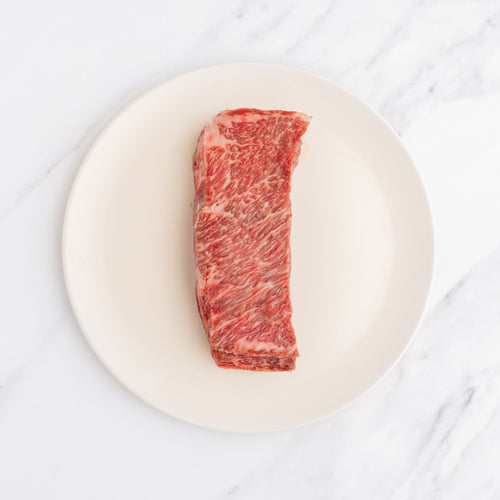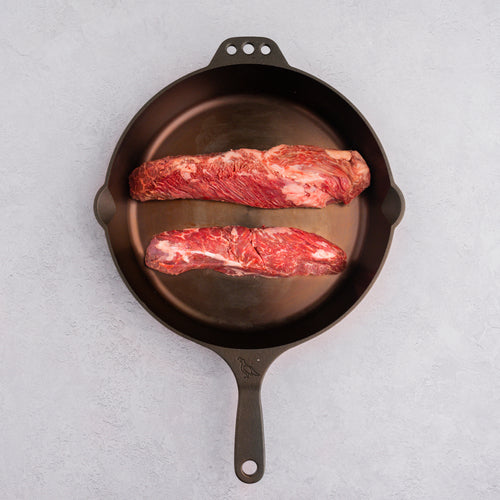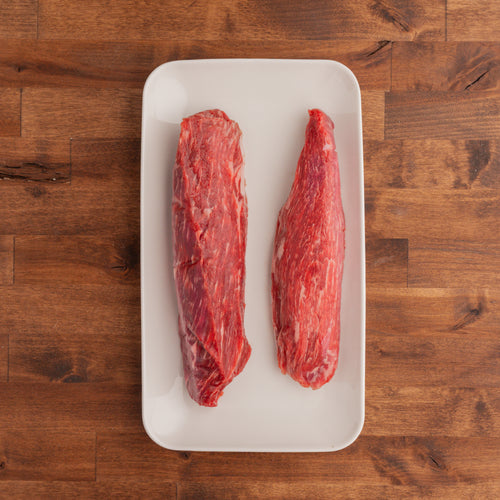
Specialty Steak Deep Dive
Steak enthusiasts are well-acquainted with the prestigious "Big Three" – ribeye, filet mignon, and strip steaks. These cuts are sought after and renowned for their sumptuous flavor and tender texture. All three originate from the rib and loin sections, often referred to as the "middle meats" due to their location.
But what about the lesser-known specialty steaks? These cuts are sometimes dubbed "butcher's cuts" as they represent value-packed options that butchers reserve for themselves. Join us as we delve into our favorite specialty cuts and take a closer look at their origins.
Zabuton
Primal: Chuck
The Denver steak, or zabuton, comes from the shoulder or chuck primal. It is a unique rectangular shaped steak that’s thick with marbling which gives the steak a distinctive buttery flavor and texture.
The zabuton comes from the chuck, or shoulder. This area is made up of three muscles, the primary being the serratus ventralis. This muscle is in the chuck below the shoulder blade and continues back to the ribs and backbone. It’s also known as the Beef Chuck, Under Blade Roast. Other cuts from the underblade area tend to be tough and end up as ground beef or stew meat. But the highly marbled Zabuton is a shining exception. > Shop Zabuton
Hanger Steak
Primal: Plate
The hanger steak has a robust beef flavor and is tender when cut across its coarse grain. It’s best seared quickly on a screaming hot grill or skillet and is excellent for carne asada and steak frites.
Also known as the hanging tender, this steak is a soft, grainy-textured elliptical shaped muscle attached to the diaphragm and the lumbar/thoracic vertebrae. Its name comes from the fact it literally hangs just below the tenderloin on the inside of the left of the hindquarters. There is only one hanging tender per carcass, which is one of the reasons it’s a cut that is not widely available. > Shop Hanger
Teres Major
Primal: Chuck
The teres major, also known as a petite tender or shoulder tender, is has tender texture and a rich savory flavor. It’s shaped like a small tenderloin roast and is best cooked using hot, dry heat. Prepare it whole or cut it into medallions.
The teres major requires a skilled butcher to remove it from the chuck or shoulder. The primal is often referred to as the clod or shoulder clod and consists of a large number of muscles. Teres major is the name of the muscle where this tender cut is sourced. > Shop Teres Major
Tri Tip
Primal: Sirloin
The tri tip is large, lean cut that’s bursting with flavor. Tri tip is the featured cut for Central California BBQ where this crescent shaped roast is prepared using only salt and pepper and grilled to medium rare.
The tri tip is cut from the bottom of the sirloin primal. The specific muscle is the tensor fasciae latae, located near the bavette, so it has the same lean characteristics. The tri tip is a thick cut that is sometimes sliced into steaks, although we prefer to prepare it as a roast. > Shop Tri Tip
Bavette
Primal: Loin/Sirloin
The bavette is a large cut and is also called the bottom sirloin flap or flap meat. Although not highly marbled, it has a full-bodied beef flavor and has a wide coarse grain with a firm bite. It’s a popular steak the world around and is used in Asian, Latin American and French cuisines.
The bavette comes from the bottom of the sirloin primal near the flank, specifically the obliquus abdominis internal muscle, which supports the surrounding areas. Since it does not receive a large amount of use, it maintains a good level of tenderness. Bavette means “bib” in French and describes the shape of this steak when whole. > Shop Bavette
Outside Skirt Steak
Primal: Plate
Outside skirt is highly marbled which melts beautifully to provide beefy flavor and a juicy texture. A distinctive feature is its coarse grain which makes it a perfect candidate for marinades.
Outside skirt steak can be found in the plate primal. The outside skirt is the diaphragm muscle and is full of flavor because it is constantly in motion. Despite its heavy workload, the outside skirt is tender and has a very pronounced grain that runs across the narrow portion of the cut. It is important to cut this steak against the grain to maximize its tenderness. > Shop Outside Skirt
Flank
Primal: Flank
The flank steak is surprisingly tender and packed with rich flavor. It’s a uniform, elongated shape with a distinct grain that runs the length of the steak. Some equate the flank with London Broil, which is a preparation method, not an actual beef cut.
The flank steak’s source is easy to remember. It comes from the flank primal and is a single muscle, called the rectus abdominus, that requires minimal butchering. > Shop Flank
Visual Learner? See our short video on "How to Slice Flank Steak".







